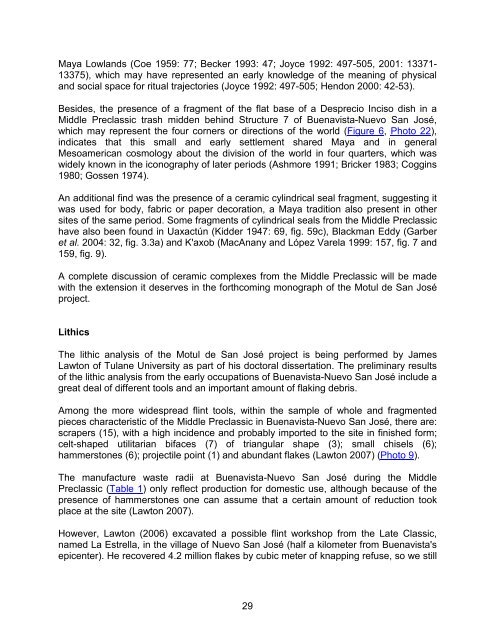Buenavista-Nuevo San José, Petén, Guatemala: Another ... - Famsi
Buenavista-Nuevo San José, Petén, Guatemala: Another ... - Famsi
Buenavista-Nuevo San José, Petén, Guatemala: Another ... - Famsi
Create successful ePaper yourself
Turn your PDF publications into a flip-book with our unique Google optimized e-Paper software.
Maya Lowlands (Coe 1959: 77; Becker 1993: 47; Joyce 1992: 497-505, 2001: 13371-<br />
13375), which may have represented an early knowledge of the meaning of physical<br />
and social space for ritual trajectories (Joyce 1992: 497-505; Hendon 2000: 42-53).<br />
Besides, the presence of a fragment of the flat base of a Desprecio Inciso dish in a<br />
Middle Preclassic trash midden behind Structure 7 of <strong>Buenavista</strong>-<strong>Nuevo</strong> <strong>San</strong> <strong>José</strong>,<br />
which may represent the four corners or directions of the world (Figure 6, Photo 22),<br />
indicates that this small and early settlement shared Maya and in general<br />
Mesoamerican cosmology about the division of the world in four quarters, which was<br />
widely known in the iconography of later periods (Ashmore 1991; Bricker 1983; Coggins<br />
1980; Gossen 1974).<br />
An additional find was the presence of a ceramic cylindrical seal fragment, suggesting it<br />
was used for body, fabric or paper decoration, a Maya tradition also present in other<br />
sites of the same period. Some fragments of cylindrical seals from the Middle Preclassic<br />
have also been found in Uaxactún (Kidder 1947: 69, fig. 59c), Blackman Eddy (Garber<br />
et al. 2004: 32, fig. 3.3a) and K'axob (MacAnany and López Varela 1999: 157, fig. 7 and<br />
159, fig. 9).<br />
A complete discussion of ceramic complexes from the Middle Preclassic will be made<br />
with the extension it deserves in the forthcoming monograph of the Motul de <strong>San</strong> <strong>José</strong><br />
project.<br />
Lithics<br />
The lithic analysis of the Motul de <strong>San</strong> <strong>José</strong> project is being performed by James<br />
Lawton of Tulane University as part of his doctoral dissertation. The preliminary results<br />
of the lithic analysis from the early occupations of <strong>Buenavista</strong>-<strong>Nuevo</strong> <strong>San</strong> <strong>José</strong> include a<br />
great deal of different tools and an important amount of flaking debris.<br />
Among the more widespread flint tools, within the sample of whole and fragmented<br />
pieces characteristic of the Middle Preclassic in <strong>Buenavista</strong>-<strong>Nuevo</strong> <strong>San</strong> <strong>José</strong>, there are:<br />
scrapers (15), with a high incidence and probably imported to the site in finished form;<br />
celt-shaped utilitarian bifaces (7) of triangular shape (3); small chisels (6);<br />
hammerstones (6); projectile point (1) and abundant flakes (Lawton 2007) (Photo 9).<br />
The manufacture waste radii at <strong>Buenavista</strong>-<strong>Nuevo</strong> <strong>San</strong> <strong>José</strong> during the Middle<br />
Preclassic (Table 1) only reflect production for domestic use, although because of the<br />
presence of hammerstones one can assume that a certain amount of reduction took<br />
place at the site (Lawton 2007).<br />
However, Lawton (2006) excavated a possible flint workshop from the Late Classic,<br />
named La Estrella, in the village of <strong>Nuevo</strong> <strong>San</strong> <strong>José</strong> (half a kilometer from <strong>Buenavista</strong>'s<br />
epicenter). He recovered 4.2 million flakes by cubic meter of knapping refuse, so we still<br />
29
















